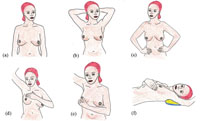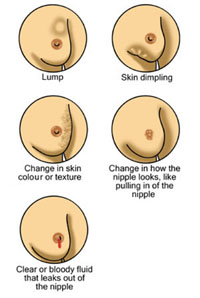3.5.1 Screening for breast cancer
![]() Advise women who find a breast lump to seek medical help – they should not to go to the traditional healers.
Advise women who find a breast lump to seek medical help – they should not to go to the traditional healers.
Screening refers to any method of examining an apparently healthy person to see if they have the early signs of a particular disease, which would benefit from having early treatment. Screening for breast cancer is easily carried out by women themselves. You should advise women in your community to examine their breasts once every week, using the method of breast self-examination illustrated in Figure 3.3 and described in Box 3.2.

Box 3.2 Steps in breast self-examination
The following steps relate to the diagrams in Figure 3.3 and should be carried out in this order.
- a.View the breasts with arms down at your sides. One breast is normally a little larger than the other, but do they appear about the same size and shape? Is the outline of each breast rounded and smooth, or are there any creases or dimples?
- b.Look at your breasts for the same signs as in (a), but this time with your arms raised and your hands holding each other behind your head.
- c.Repeat the visual inspection with your hands on your hips.
- d.Raise your right hand above your head; with all four fingertips of your left hand, gently press the whole of your right breast, moving your fingers to the next area and using small circular movements. Feel for any lumps or thickened tissue. Repeat with the left breast and right hand.
- e.Hold your right nipple between the thumb and first finger of your left hand; gently roll the nipple, feeling for any lumps or tenderness. Repeat with the left breast.
- f.Lie down and stretch your left arm upwards and behind your head. Use small circular pressures with the finger tips of your right hand to examine the whole breast. Repeat with the right breast and left hand.
If a woman feels an unusual lump or any palpable mass in the breast, or sees a change in the appearance of the breast, she should go to the nearest health centre for further assessment and specialist treatment. The types of changes in the appearance or ‘feel’ of the breast that should alert a woman to seek medical help are shown in Figure 3.4.

There are also image screening methods for early detection of breast cancer in higher health institutions, using either low-dose X-rays (the technique is called mammography) or ultrasound imaging of the breast. In many high-income countries, all women over the age of 45 or 50 years are screened using these methods every two or three years. However, the technology is not available (or not accessible) in most low-income countries in Africa.
3.5 Breast cancer
